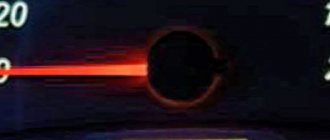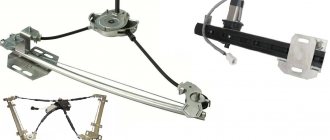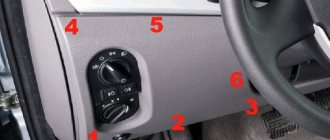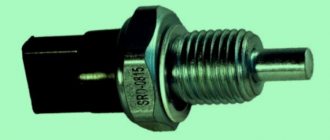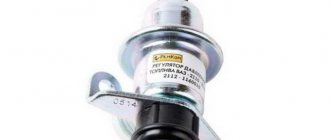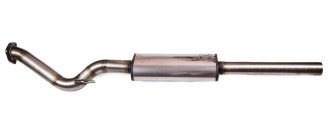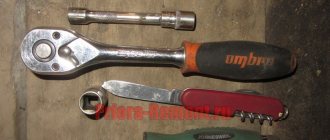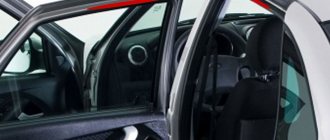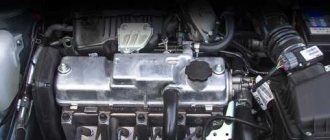Lost thrust from Lada Kalina engine
quote: maybe the idle is overflowing?
quote: Originally posted by ilja316: petrol engines replaced
quote: Originally written KIA 18: ilja316 good afternoon namesake) First of all, for diagnostics.
Hello!) Yes, I changed both
quote: Originally posted by Vad10: Is the oil level normal?
Thank you! Yes, I also thought about the ignition module
quote: Originally posted by AlexLiss-ar:
100 pounds high-voltage transformer.
quote: Originally written by ilja316: Yesterday evening, when returning home, the car began to stall, at times the traction was lost at speeds above 2.5 thousand. This morning I drove for about 10 minutes and pulled normally, after that the traction suddenly disappeared, it doesn’t even pull itself on a flat surface, the check engine light doesn’t light up
quote: Originally posted by vovchiky: well, that means somewhere the wires have rubbed against the engine, look at the harness on the injectors
Shouldn't the check light come on?
quote: Originally posted by VAVAN faza:
do you have viburnum? In January the error would most likely have popped up.
then there was a seven injector.
If the high-voltage coil is broken, which is more likely, the error will most likely not appear.
quote: maybe the idle is overflowing?
quote: I suspect that the RTD, fuel pump, TPS and contacts
quote: 100 pounds high-voltage transformer
quote: Thank you! Yes, I also thought about the ignition module
quote: do you have viburnum? In January the error would most likely have popped up.
quote: well, that means somewhere the wires have rubbed against the engine, look at the harness on the injectors
quote: back then there was a seven injector. If the high-voltage coil is broken, which is more likely, the error will most likely not appear.
Not quite clear. Isn’t it easier to go somewhere to a trusted place, pay a ridiculous amount and forget, than to read, write nonsense and suffer with the car, while changing the floor of the car in vain?
quote: Originally posted by vic-18: Didn’t you find it yourself?
I stopped by the nearest service center in the morning and asked to measure the pressure in the fuel rail. We moved on from this
quote: Originally posted by vic-18: I won’t believe it in my life!
quote: Originally posted by vic-18: And even the new high-voltage transformer was not useful?
quote: Originally posted by vic-18:
Didn't you find it yourself? I won’t believe it in real life! And even the new high-voltage transformer was not useful? and didn’t overfill the idle?
quote: Originally posted by AlexLiss-ar:
100 pounds high voltage transformer
quote: Originally written vic-18: “high voltage coil”
quote: well, why troll? the person found the reason, figured it out himself, but the fact that he calls things by other names, the understanding of these things does not change, because, I think when they wrote
Source
The main reasons for the reduction in engine power
Crankshaft position sensor malfunction
There are situations when the DCPV untimely sends a control command to supply the air-fuel mixture. As a result, the power of the power unit drops before our eyes. The main cause of the failure is the shift of the toothed star relative to the pulley and the delamination of the damper. In such a situation, it is necessary to carefully inspect the damper and replace it.
Increasing (decreasing) the gap between the spark plug electrodes
During operation, due to strong temperature effects, the distance between the electrodes of the spark plug may decrease or increase. To exclude or confirm your suspicion, you need to check the size of the gaps using a round feeler gauge. If the distance is less or more than acceptable, you need to make an adjustment by bending the side of the electrode or replace the spark plug. As for the optimal spark gap distance, it can be different (depending on the type of spark plug) - 0.7-1.0 mm.
The appearance of carbon deposits on the spark plugs is another clear sign of a problem.
If the engine does not pull well, you need to unscrew all the spark plugs one by one and inspect them. If obvious carbon deposits appear on the electrodes, the device must be cleaned using a brush with metal bristles. It is important not only to clean the spark plugs or replace them, but also to find out the cause of this phenomenon.
Failure of spark plugs
A decrease in engine power may be caused by product failure. In this case, it is necessary to check the performance of the spark plug on a special stand. If the suspicions are confirmed, then the only way out is to replace the set or one spark plug.
There is no gasoline in the tank
You can diagnose the problem using the fuel level indicator. If it is faulty or there is a suspicion that it is “inadequate,” then the presence of fuel can be determined by removing the fuel pump.
Fuel filter contamination, water freezing in the system, pinched fuel wire, fuel pump failure
All these malfunctions can be safely classified into one category, because they all have the same symptoms - the starter cranks the engine, but there is no smell of fuel from the exhaust pipe. If the car has a carburetor, then the reason must be sought in the float chamber. Most likely, fuel is not supplied to it. In the case of an injector, it is easier to check the presence of fuel in the ramp by pressing a special spool (installed at the end of the ramp).
To correct the problem, you need to warm up the engine thoroughly and bleed the power system with a tire pump. After this, all system pipes, hoses and the fuel pump itself are changed.
Wear of sealing gaskets
The design feature of the engine requires the presence of sealing gaskets. They make the engine structure more airtight. If the gaskets in the area of the manifold or cylinder block are worn out or have lost their tightness, then when you press the gas pedal, the engine may stall.
If the gasket burns out, coolant penetrates into the engine in the area of the cylinder block. In this situation, the engine continues to operate, but the number of revolutions decreases sharply. You may notice white smoke coming from the exhaust pipe.
The driver, faced with the problem of turning off the engine, finds himself in an extremely unpleasant situation. In order to eliminate this difficulty, you need to know the reason for its occurrence.
How to repair the idle speed control
In fact, the injector does not need to be adjusted, because the intelligent on-board control system is responsible for the operation of the machine. The idle speed regulator, built into the injector, is a mechanism that opens and closes the air flow again, and the air itself passes through a channel specially equipped for this. Unfortunately, it is difficult to determine the exact breakdown of the idle air control (IAC) based on the readings on the on-board panel - the fault signal will not light up. But what will immediately become apparent is the instability of the rotations or their complete disappearance. If there is a “Check” signal on the instrument panel of the VAZ-2107, it is quite possible that the IAC is to blame. This means that the engine is detonating, and this signal is transmitted to the control unit, which is powered by electronics.
Analysis of the causes of poor engine traction and possible repairs
Fuel filter dirty
This may be due to low-quality gasoline (containing various small debris) or infrequent cleaning of the fuel tank. In this case, you will have to completely replace the entire filter system.
Fuel pump diaphragm clogged
The cause of the blockage, as a rule, is low-quality gasoline. To clean it, just remove the diaphragm and rinse it thoroughly or blow it with air.
Malfunction of the sensor that controls air flow
This is the most common reason why the VAZ 2114 does not work.
It is worth periodically checking the operating condition of the air flow meter to avoid wasting time and money diagnosing the engine.
Air filter dust
The more the filter is clogged with dust, the less air flows to the engine, therefore, the thrust decreases. What can be done in this case? Ideally, the filter should be replaced with a new one, but if this is not possible, you should remove the filter, tap and blow to remove large debris (flies, dry leaves, insects).
How to repair an injector in a VAZ-2107
If replacing the sensors does not produce results, it is better to go to a service station. The banal lack of tightness of the intake manifold provokes the same problem when the car stalls at idle. With your own hands, inspect the vacuum hoses, gaskets, injector sealing rings, and then the plugs that are located in the manifold, and the vacuum brake pedal booster. It is easy to detect air leaks using a special unit called a smoke generator. Do not ignore checking the gasoline pressure.
If a pressure regulator is installed on the VAZ-2107 ramp, the optimal value fluctuates around 2.5 bar, but this is only at idle without a vacuum device. With a vacuum device, a value of 3.8 to 4 bar is permissible. Spark plugs must also be checked.
How to clean the VAZ-2107 injector nozzle is shown in the video:
LADA Kalina, Lada Kalina - we determine why the speed jumps, the car stalls
If your Lada Kalina car stalls, before going to a car service center, you should know the possible reasons why the speed jumps and your car stalls. First, look, the car stalls only at idle, when you have started, but have not yet moved, or stalls while driving, or stalls in both cases, both ways. Then pay attention to the engine, when you start and drive away, it stalls immediately or starts to jerk (triple) and then stalls. Why is this necessary? So that the service can give you the correct diagnosis and not take extra money from you. Remember!!! There are many reasons why a car can stall and the speed drop!!! Which mechanic will never tell you right away!!! He will act by elimination. First he will tell you to replace one thing, if it doesn’t help, replace the second, third... and so on, and this is your money. And if you don’t want to spend extra money and save your time and nerves, go straight to a diagnostician who will connect to the electronic control unit in your car and see what errors the computer gives. Better yet, buy an on-board computer and see for yourself what errors the car produces.
Replacing the oxygen sensor Kalina
Let's consider the possible reasons when a car stalls and how to avoid unnecessary costs for purchasing spare parts that they will offer you to buy and replace at a car service: 1) The very first and main thing a mechanic looks at is a malfunction of the oxygen sensor.
If the diagnostician shows an oxygen sensor error, or your on-board computer displays it, you will be offered to buy an oxygen sensor to replace it. Don’t rush to run out and buy an oxygen sensor (OS). Let's look at where the oxygen sensor (OK) is located and what it is connected to. A cord of wires comes from the DC, at the end of which there is a connecting plug. This plug fits into a plug from which the wiring harness goes to the electronic control unit (ECU). But the most interesting thing is that the factory sometimes installs the connection of the oxygen sensor to the harnesses that go to the ECU not directly, but through another adapter, and if this adapter is faulty, the computer also gives a DC error, despite the fact that the oxygen sensor itself is working. If you have such an adapter, ask to check its serviceability; if it is faulty, run to the store for a new one. If you do not have such an adapter, then ask an electrician to see if the wires of the harnesses from the ECU are bent or broken at the point where they connect to the plug. If there is a problem there, the electrician will solder a new plug there. If everything is in order there, have an electrician check to see if the wires coming from the oxygen sensor (OS) are broken or frayed where they connect to the plug. If there is a problem there, then you should not agree to resolder the plug; it is better to buy a new oxygen sensor. But know that replacing it does not always solve the problem that is causing the car to stall. Let's consider the second reason why a car may stall and the idle speed drop...... engine, Kalina, Lada, error, repair
If the engine does not pull (loss of power, dips or jerks)
| What to do if the dynamics of the car have decreased significantly, and it is no longer possible to overtake the car so quickly? There can be many reasons for this engine problem, and the main ones are listed in this table. |
| Possible cause of malfunction | Checking (diagnosis) of a malfunction | Troubleshooting methods |
| The control impulse from the DPKV arrives at the wrong time due to delamination of the crankshaft damper (the gear has moved relative to the pulley) | Visual inspection of the damper. | Replace damper. |
| The gap between the spark plug electrodes is not normal | Check the gaps with a feeler gauge. | Set the required gap by bending the side electrode, or replace the spark plugs (see which spark plugs to choose). |
| Heavy carbon deposits on spark plugs | Visual inspection. | Clean the spark plugs. Identify and eliminate the cause of soot formation. If necessary, replace the spark plugs (see which spark plugs to choose). |
| Non-functional spark plugs. | Candles are checked on a special stand. | Replace the spark plugs (see which spark plugs to choose). |
| There is no gasoline in the fuel tank | The fuel level indicator shows an empty tank. Determine the presence of gasoline by removing the fuel pump. | Pour gasoline into the tank. |
| The fuel filter is clogged, the water in the engine power system is frozen, the fuel line is pinched, or the fuel pump is faulty | The starter cranks the crankshaft, but there is no smell of gasoline coming from the exhaust pipe. (Carburetor) There is no gasoline in the float chamber of the carburetor - when you press the gas pedal there is no jet of fuel from the accelerator pump nozzle. (Injector) The presence of gasoline (under pressure) in the fuel rail can be checked by briefly pressing the spool of the fitting at the end of the rail (see about pressure in the fuel system). | Warm up the car and blow out the power system (with a tire pump). Replace the fuel pump, hoses and tubes. |
| The fuel pump does not create the required pressure in the fuel system | Check the pressure at the outlet of the fuel pump (see about pressure in the fuel system). Check the fuel pump filter. | Clean the fuel pump filter. Replace the fuel filter (see which filter to choose) and the fuel pump, which does not provide the required pressure. |
| Poor contact in the fuel pump power circuit or its relay is faulty | Checked with an ohmmeter. Check the "mass". | Clean the contacts, crimp the terminals, replace the relay (see mounting block) and wires. |
| Faulty injectors or their circuits | Check the injector windings and their circuits with an ohmmeter for open circuits and short circuits. The ECU is diagnosed at a service station. | Replace the faulty ECU (see ECU interchangeability). Clean the injectors or replace them with new ones (see which injectors to choose). Ensure contact in electrical circuits. |
| Inoperative crankshaft position sensor (CPS) or its circuit | The “Check engine” lamp is on. Check the DPKV circuit, the absence of damage to the sensor itself and the gap between it and the crankshaft damper ring gear (1±0.2 mm). Sensor resistance is 500–700 Ohms. | Restore contact in electrical circuits, replace the faulty sensor. |
| Inoperative coolant temperature sensor (DTOZH). | The “Check engine” lamp is on. If there is a break in the DTOZH or its circuit, the electric fan of the cooling system runs continuously. Check the DTOZH. | Restore contact in the electrical circuits, replace the faulty sensor. |
| The throttle position sensor (TPS) or its circuit is faulty | The “Check engine” lamp is on. If there is a break in the circuit or sensor, the engine speed does not drop below 1500. | Clean the throttle assembly, restore contact in the electrical circuits, replace the faulty sensor. |
| Inoperative mass air flow sensor (MAF) | Check the mass air flow sensor, or replace the sensor with a known good one. | Clean the mass air flow sensor, replace if necessary (see which mass air flow sensor to choose). |
| Inoperative knock sensor | If the wire is broken, the “Check engine” lamp lights up. There is no detonation in any mode. Loss of engine power. | Restore contact in electrical circuits, replace the faulty sensor. |
| Inoperative oxygen sensor or circuit | "Check engine" light is on. The integrity of the heating coil is checked with an ohmmeter, the output voltage is checked with a voltmeter (the voltmeter should be connected without breaking the circuit, for example, by piercing the wires with thin needles). | Repair the oxygen sensor. Restore the wiring, clean the air leak hole. Replace the oxygen sensor. |
| Leakage of the exhaust system (area up to the oxygen sensor) | Visual inspection at medium engine speed. | Replace the exhaust manifold gasket, tighten the seals (see replacing the exhaust manifold). |
| The engine control unit (ECU) and its circuits are faulty | Check the 12V voltage at the ECU. Replace the unit with a known good one. | Replace the ECU (see ECU interchangeability), wiring. |
| Inoperative fuel pressure regulator (FPR) | Check the pressure in the fuel rail. | Replace the regulator (see which regulator to choose). |
| The clearances in the valve drive are not adjusted (8-valve engines) | Check with a set of feeler gauges. | Adjust valve clearances. |
| Loose or broken valve springs (8-valve engines) | Inspection, measurement of the length of springs in a free state and under load. | Replace weak or broken springs. |
| Wear of camshaft cams/shafts | Visual inspection. | Replace camshaft. |
| The valve timing is off | Check the alignment of the marks on the crankshaft and camshaft. | Establish the correct relative position of the shafts (according to the marks). |
| Low compression in the cylinders (wear or damage to valves, seats, wear, sticking or breakage of piston rings) | Check compression in cylinders. | Replace rings and pistons. Cylinder repair. |
| (Carburetor) Engine is not warmed up | According to the temperature indicator | Warm up the engine at medium speed to operating temperature. |
| (Carburetor) Insufficient fuel level in the carburetor float chamber | — | Adjust the fuel level. |
| (Carburetor) The carburetor trigger or drive is faulty or not adjusted. | — | Adjust the starter or replace it. |
| (Carburetor) Excessive fuel level in carburetor float chamber | There is a strong smell of gasoline from the exhaust pipe; a cold engine starts better than a hot one. Remove the top cover of the carburetor and check the integrity of the floats, their ease of movement and the absence of touching the walls of the float chamber. To check the tightness of the needle valve, turn the carburetor cover with the floats up and pump up gasoline using the fuel pump lever. Gasoline leakage from under the needle or valve base is unacceptable. | Replace the needle valve. Adjust the fuel level in the float chamber. |
| (Carburetor) Over-rich mixture due to gasoline leaking into the engine crankcase through a torn fuel pump diaphragm | The oil on the dipstick smells like gasoline. The low oil pressure light comes on at idle speed. | Replace the fuel pump or diaphragm. Change the oil if it contains a lot of gasoline. |
| (Carburetor) The carburetor jets and passages are clogged. The jets and solenoid valve are not tightly wrapped | Inspect and blow out the channels and jets. | Wash with gasoline or acetone and blow out the jets. If they are heavily soiled, clean them with a fishing line or a soft wood needle. |
| Incomplete opening of the throttle valve/flaps | Inspection with the engine stopped. | Adjust the throttle valve drive. |
| (Carburetor) Accelerator pump or nozzle not working, carburetor fuel passages clogged | Check the pump supply and make sure there is no leakage of gasoline from under the diaphragm. Make sure that the accelerator pump lever moves freely. | Replace damaged parts, tighten threaded connections, and blow out valves. |
| (Carburetor) Incorrect ignition timing | — | Adjust the ignition timing. |
| (Carburetor) Wear, damage to the contact carbon in the ignition distributor cap. The coal spring has weakened | Visual inspection. | Replace the distributor cap or the angle with the spring. |
| (Carburetor) The resistor in the ignition distributor rotor has burned out | Checked with an ohmmeter (1 kOhm). | Replace resistor or rotor. |
| (Carburetor) Commutator faulty | Testing is carried out by installing a known-good switch. | Replace the switch. |
| (Carburetor) Weakening or breakage of the springs of the weights of the centrifugal automatic ignition distributor, the damper rings of the weights are lost, the weights are stuck | Visually and at a special stand. | Replace the ignition distributor. |
| (Carburetor) Fuzzy operation of the vacuum ignition timing regulator; when the vacuum is removed, the plate does not return to its original position, there is large play in the bearing | Determined by visual inspection. The characteristics of the vacuum regulator are measured on a special stand. | Eliminate the jam, replace the faulty vacuum regulator or ignition distributor. |
| (Carburetor) The fuel pump does not create the required pressure in the system | — | Replace the fuel pump or its diaphragms. |
Electronics problems
Unstable engine operation may occur due to difficulties with the vehicle's electronic system. A large number of operations in the machine are performed under the control of the ECU. If the sensors malfunction, they send erroneous commands to the engine. In most cases, the throttle sensor is affected.
The error is the idle speed is not working properly. Normally, when you press the gas, the volume of fuel supplied should increase, but in reality, on the contrary, it only becomes smaller or stops completely. If you correctly adjust the sensor in a service center, you can solve this problem.
The coolant temperature sensor can also cause the car to brake when the gas pedal is pressed. If the sensor breaks, the engine stops working at high speeds. The ECU system is activated. In the absence of any signals from the sensor, the engine speed may drop to zero.
If the driver wants to increase the gas, the engine is turned off. The sensor must be checked. In most cases, repairing it is impossible; the sensor is replaced with a new device.
Stuttering when accelerating? Dig! — logbook Lada Kalina Sedan 2006 on DRIVE2
As you know, every car requires attention. So mine demanded it. Sluggish acceleration, vibration, consumption, shocks when switching. List of suspects:1. MAF sensor. I recently measured www.drive2.ru/l/477094589040165062/. The multimeter reading is 1.04 V.
According to the diagnostics, it showed 1.016 V. There is a third way - remove the chip from the mass air flow sensor and drive it. I haven't tried it.
2. Candles. I forgot to take a photo. Yesterday I took it off, like new. Candles cost 17 dv. www.drive2.ru/l/473344429755728085/. I'm going to install DENSO.
3. Air filter. Yesterday I took it out dirty. I blew it out from the compressor. I was breathing better. It was easier to go.
photo from the Internet. It looks like it was for me.
4. I have long wanted to try running antifreeze past the throttle valve. The fitting was used from an old radiator.
5. Corrugation. www.drive2.ru/l/478326591819088066/. I've seen some cars come out inside. I thought so too. It turned out not. It just rattled and siphoned. Although sound could also play a role. After replacement the vibration went away.
6. It remains to look at the injectors. There is no smell of gasoline. But the O-rings have already been purchased. I took washing for the injector and valves. I'll do it as soon as I fill the tank full. After this, you will need to replace the spark plugs as recommended.
Why doesn't the car pull and what needs to be checked in this case?
If the car does not show its former power and traction, you will not get any pleasure from driving. Moreover, the consumption of gasoline or diesel fuel often increases, and the risk of failure of any units increases. The car owner intuitively understands that something is wrong in the design of the vehicle. Therefore, there is a desire to check the car, find the cause of the defect and get specific solutions to the problem. Today we will talk about why the car does not pull, and also what needs to be done in such situations, where you should look first. If you encounter such a problem suddenly, it is worth quickly diagnosing the main components of the machine, identifying the problem and eliminating the cause of the loss of power. If the problem has been present for a long time, it’s time to go to a service station and solve this issue.
If you drive for a long time with most of the problems that cause loss of traction, you can completely ruin the power unit and end up needing expensive repairs. So we strongly recommend that you immediately pay attention to a noticeable loss of engine power or a real feeling that someone is holding you by the exhaust pipe and is not allowing you to accelerate. The longer you think it will go away over time, the more damage you can do to your car. This will also cause excessively expensive repairs in the long run. Let's consider the main reasons for this phenomenon.
Stop driving with the handbrake, and traction will appear by itself
If you always set your car's handbrake but forget to release it while driving, prepare for compromised traction. When driving with the handbrake, you get the feeling that the car accelerates very slowly and it is too difficult to gain momentum. The driver immediately puts pressure on the engine, putting pressure on the suspension or gearbox. But he can’t even think that it’s enough to lower the handbrake lever for the problem to solve itself. Moreover, driving with the handbrake for quite a long time will cause the following troubles with the car:
Source
The engine stalls regularly - the throttle position sensor is broken
Regular stopping of the car engine may indicate that the problem is a malfunction of the throttle sensor. This sensor measures the force when you press the gas. The data goes to the ECU (electronic control unit) of the propulsion system. The volume of fuel that should be injected into the combustion chamber of the engine is calculated.
This operation is carried out unnoticed by the driver, in a split second.
If the damper sensor provides erroneous information, injection of the required amount of fuel may not occur. This moment can often be observed when the driver presses the gas pedal. Only a mechanic can perform a quality check of the functioning of the sensor. This requires special knowledge.
As an additional signal, you can pay attention to the “Check Engine” indicator. If it lights up, then it can be assumed that there is a breakdown of the throttle sensor.
